May 27, 2018 | coins, currency, dollar, foreign
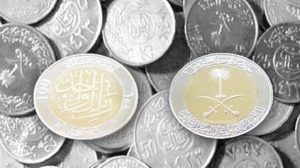
Saudi Arabia to replace the one-riyal note with coins (Image courtesy of Asharq Al-Awsat)
SAMA made the announcement as part of their introduction of new coin designs using modern techniques in coin manufacturing.
Under their transition plan, SAMA will allow the SR1 paper note to circulate alongside the new coin as the notes will be withdrawn from circulation. When the coins become available, the banks will be ordered to replace the SR1 note with a coin based on an availability formula that will be provided when the coins are ready for circulation.
According to Society for Worldwide Interbank Financial Telecommunication (SWIFT), the company that runs the network that enables the world’s financial institutions to security send financial transactions to each other, the United States dollar makes up 40.86-percent of every transaction in the world (as of February 2017). The United States Gross Domestic Product (GDP), the measure of an economy’s output, is over $19 trillion (in 2017 according to the International Monetary Fund) more than any country or trading cooperative (such as the European Union). But the United States is the only country ranked in the Top 10 of either of these lists to continue to produce its unit currency in paper form.
For a country that is supposed to be a leader, it looks like the United States has fallen behind the rest of the world. It is time to eliminate the one-dollar Federal Reserve Note.
And now the news…

May 20, 2018
A new £1 coin could actually end up earning you hundreds thanks to a Royal Mint 'error'. Three examples of the error have already been seen by ChangeChecker – and they are selling for more than £200.  → Read more at bristolpost.co.uk
→ Read more at bristolpost.co.uk

May 22, 2018
Prosecutors won’t pursue charges against a drummer accused of stealing rare coins and a passport from famed New Orleans musician Fats Domino.  → Read more at pagesix.com
→ Read more at pagesix.com

May 22, 2018
The sifting project, which has operated since 2004 in the Emek Tzurim National Park, aims to salvage religious and historical artifacts from the rubble, as well as to educate the public about the veracity of Jewish history on the Mount.  → Read more at jns.org
→ Read more at jns.org

May 22, 2018
Aaron Judge and Michael Conforto are two of the young stars that New York baseball fans have been buzzing about the past two years. Now fans of the Yankees and Mets outfielders can now get the star…  → Read more at nysportsday.com
→ Read more at nysportsday.com

May 24, 2018
2018 Baseball Treasure MLB Coins checklist, release date, silver and gold coin info and all you need to know about the officially licensed set of baseball coins.  → Read more at beckett.com
→ Read more at beckett.com

May 25, 2018
The much-ballyhooed summit between the United States and North Korea met its end Thursday. The cancellation, for now, stamps out the prospects for peace, yet does nothing to stop the snazzy coins featuring Donald Trump and Kim Jong Un in front of patriotic backdrops surrounded by olive branches  → Read more at cnn.com
→ Read more at cnn.com

May 25, 2018
The Saudi Arabian Monetary Authority (SAMA) will start withdrawing SR1 banknotes from the market from Thursday, SAMA has said. In a statement, SAMA announced issuing its sixth edition, which was developed during the reign of the Custodian of the Two  → Read more at aawsat.com
→ Read more at aawsat.com
May 12, 2018 | currency, fun
A few weeks ago while watching Jeopardy!, I noticed they had a category “On Big Money.” The premise was to name the person whose portrait is on high denomination currency—notes with a face value of $500 and greater.
I wrote down the questions and decided to create my own version of Jeopardy! How many can you answer, or ask correctly? Remember, in Jeopardy! you have to answer in the form of a question.
It’s Saturday… let’s have a little fun!
Click on the image to see the question.
How well did you do?
For those unsure of the questions that coincide with the answers, click on the value of the question in the tab to see the explanation.
The $200 Answer
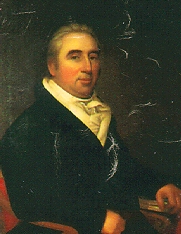
William Marbury
The answer is a reference to the case
Marbury v. Madison resulting from a petition to the Supreme Court by William Marbury, who had been appointed Justice of the Peace in the District of Columbia by President John Adams but whose commission was not subsequently delivered. Marbury petitioned the Supreme Court to force the new Secretary of State, James Madison, to deliver the documents. The Court, with John Marshall as Chief Justice, found firstly that Madison’s refusal to deliver the commission was both illegal and correctable. The Court stopped short of ordering Madison (by writ of mandamus) to hand over Marbury’s commission, instead holding that the provision of the Judiciary Act of 1789 that enabled Marbury to bring his claim to the Supreme Court was itself unconstitutional, since it purported to extend the Court’s original jurisdiction beyond that which Article III established. The petition was therefore denied. (Wikipedia)
The $400 Answer
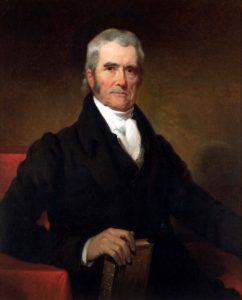
Chief Justice John Marshall
John Marshall (1755-1835) was nominated for Chief Justice of the Supreme Court by President John Adams. Marshall became the fourth Chief Justice on January 31, 1801. He served on the court for 34 years until his death on July 6, 1835. Marshall was Cheif Justice for the landmark cases of
Marbury v. Madison and
McCulloch v. Maryland.
The $600 Answer

2013 William McKinley Dollar
William McKinley, the 25th President of the United States, was shot on the grounds of the Pan-American Exposition at the Temple of Music in Buffalo, New York on September 6, 1901. He was shaking hands with the public when Leon Czolgosz, an anarchist, shot him twice in the abdomen. McKinley died eight days later on September 14 of gangrene caused by the gunshot wounds. (Wikipedia)
Later that day, Theodore Roosevelt was sworn in as the 26th President at the Ansley Wilcox House in Buffalo. This made Roosevelt the youngest person (42 years, 322 days) to be inaugurated as President.
The $800 Answer
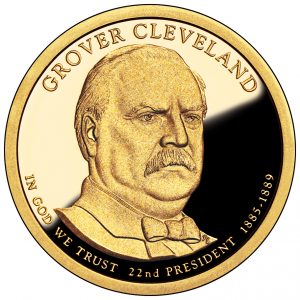
2012 Grover Cleveland First Term Dollar
Grover Cleveland was the only person to serve two non-consecutive terms as President of the United States. Cleveland was the 22nd President from 1885 through 1889. In a very contentious campaign where tariffs were the main issue, Benjamin Harrison won by a slim margin. There were accusations of voter fraud and fixed election, particularly in Indiana. Cleveland did not challenge the result and served his full term.
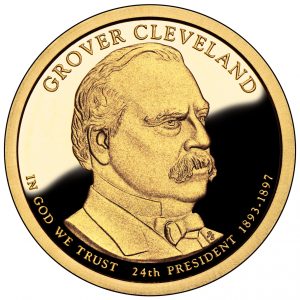
2012 Grover Cleveland Second Term Dollar
Cleveland won back the Presidency in the 1892 election in what was a very calm election for the time period. Cleveland became very vocal during the Harrison administration over monetary policy including opposing the
Sherman Silver Purchase Act. He was nominated by the Democrats to run again. Harrison did not campaign opting to be with his wife Caroline who was dying of tuberculosis. Following her death on October 25, 1888, two weeks prior to the election, all candidates suspended campaigning. Cleveland was the 24th President of the United States from 1893 through 1897.
The $1000 Answer

Salmon P. Chase, 6th Chief Justice of the Supreme Court
Salmon P. Chase (1808 – 1873) was the sixth Chief Justice of the Supreme Court. Chase was nominated by President Abraham Lincoln while serving as the 25th Secretary of the Treasury. A significant case during his tenure was when he presided at the impeachment trial of President Andrew Johnson in 1868. With 27 states and 54 senators, it required 36 (two-thirds) guilty votes to remove Johnson from office. Johnson was acquitted with 35 guilty votes and 19 not-guilty votes. Chase served on the Supreme Court from December 6, 1864, until he died on May 7, 1873.
What do you think? Is this something you would like to see more of? Let me know!
Credits
- Coin images courtesy of the U.S. Mint.
- All other images courtesy of Wikimedia Commons.
Apr 14, 2018 | currency, foreign, fun
When I go picking I look for the unusual. Whenever I walk into an estate sale or any other picking opportunity, I will find the most remote area and work from there. In most homes, I head for the basement and the garage. These are the places that people store things they did not want to throw out, It is where I find the most unusual items.
Lately, I have been finding that buying old books can be just as interesting. Aside from cultivating a small clientele of interested customers, I have found that people hide things in books, especially old books.
Not long ago I visited a difficult to find estate sale hoping to find something interesting. I did not find much but there were some books that had possibilities. At $2 each, I felt I could find a few gems.
Based on the type of books I found, the owner had a passion for European history. In addition to travel books and books about European influence on United States society, there was a two-volume set written in French.
My French is good enough to figure out that the books were published in 1899 Paris and were from the first printing of the first edition. For book collectors, once the book meets the condition test, these are the books they like. Since they were in good condition with nice covers I added them to my pile.
This past week I was going looking through the box of books. As I was cataloging them I will either scan the pages or fan them to see if I find something. Within these two volumes of French language books on European history, I found money.
I was a little surprised to see notes from the Central Bank of Egypt. Seven different Egyptian notes, mostly from the late 1980s. The face value of the notes totals 13 pounds.
-

-
Obverse of the Egyptian banknotes found in a French language book about European history.
-
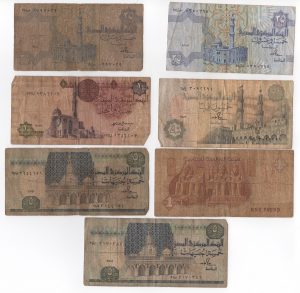
-
Reverse of the Egyptian banknotes found in a French language book about European history.
Aside from being mostly in horrible condition, I do not recall any indication of books, magazines, or catalogs referencing Egypt of the Middle East or North Africa.
The best-looking note is a 25 piastre note (Pick #57a) but it looks water damaged. It was probably water damaged before being stored between the pages of the book since the book shows no effects from the storage.
Although the notes can be worth $5 for the 25 piastre note to $25 for the 5-pound note, that would be if they were in better condition. I am not sure the entire lot is worth $5!
The moral of this story is that if you go picking at estate sales, check the bookcase. You never know what might fall out when you fan the pages.
Apr 3, 2018 | advice, currency, education, web
 Last week, I posted an article about online resources that I use when I want to begin research on a numismatic topic. The list provided a number of resources but a reader wrote to me and noted that I forgot to include paper money resources beyond the Bureau of Engraving and Printing.
Last week, I posted an article about online resources that I use when I want to begin research on a numismatic topic. The list provided a number of resources but a reader wrote to me and noted that I forgot to include paper money resources beyond the Bureau of Engraving and Printing.
Paper Money Sources
When it comes to searching for information on paper money, I always start at one of the following three sites:
The opening line at USPaperMoney.Info says that it is the “home of everything you ever wanted to know about U.S. currency. (Well, almost….)” This is truth in advertising. Even with the page of unanswered questions, the site has everything you could ever want to know about U.S. currency. I just wish the author would organize the site better.
Don and Vic’s World Banknote Gallery is one of those sites that looks like it was created by a seventh grader in 1998 but has a tremendous amount of very useful information. It is one of the best sites I have found to identify world banknotes.
They have a companion site named World Coin Gallery that is similar. I have used this site and have added it to the original bookmarks file. If you downloaded the original bookmarks then right-click (Control-click for Mac users) and select the option to add worldcoingallery.com to your bookmarks.
Last, but definitely not least, is Banknote News by Owen Linzmayer. If you want to know anything about the production of world paper money, this is the site you need to read. In addition to the information, which a lot of it is in blog form and consistently tagged for easy navigation, Linzmayer has also compiled one of the best references on world paper money called The Banknote Book. He said he did this because he and other collectors were frustrated with the “many errors, omissions, and poor-quality images” in the Standard Catalog of World Paper Money.
The Banknote Book can be purchased as a physical book as a three-volume set complete through 2014 or you can buy individual chapters corresponding to the country of your interest.
If you want to check it out for yourself, download 17 Free Sample Chapters and judge for yourself.
Currency Bookmarks
Do you want to add these links to your browser’s bookmarks? Right-click (or Mac users can CTRL-Click) on the following button and select whatever option your browser requires to save the file to hard drive. Import the file as an “HTML Bookmark” file to add these links to your bookmarks.
Mar 29, 2018 | coins, currency, education, technology, web
 I am often asked what resources I used for online research when writing articles for the Coin Collectors Blog. For more than 12 years of writing this blog, I have found hundreds of websites that I have used to various degrees. However, there are a few that have provided the best information.
I am often asked what resources I used for online research when writing articles for the Coin Collectors Blog. For more than 12 years of writing this blog, I have found hundreds of websites that I have used to various degrees. However, there are a few that have provided the best information.
No single website can provide all of the information available. This is why I keep many sources at hand. The problem is that I do not keep them in one neat location. Some of them I remember and then there are snippets of text, bookmarks, and even computer code that I refer to when I have to start looking up information. Not only will this provide you with research starting points but it also gives me a chance to organize my bookmarks!
Before I list my sources, there is one tool that must be included in any online reference: Google. Google is a great search tool because it is the only search engine that really tries to add context of the search. For example, if you are searching for something to do with coin dies you will get related items and not information about games with dice or something about death.
When searching for information using Google is to try to be as exact as possible with the search term including using characters with diacritic (accent) marks. Using the proper diacritic marks will help find foreign language sources that could provide additional information not found in English. Also, Google can search using terms that are entered using non-Latin characters including Arabic, Cyrillic, Greek, Hebrew, and Asian languages.
If you find a non-English site or a site in a language you are not familiar with, Google Translate (translate.google.com) is a great tool for translating this information. You can either enter phrases into Google Translate or enter a URL for it to download and translate pages.
Primary Sources
When it is time to find information about modern coins, currency, production totals, and images, the primary source are the government bureaus that manufacture the money.
United States Mint: www.usmint.gov
Bureau of Engraving and Printing: www.moneyfactory.gov
There is a lot that goes into the money manufacturing process in the U.S. An overview of the bureaus and other agencies can be found the U.S. Coin and Currency Production page.
Trusted Sources
Although there is quite a bit of numismatic information available online, one of the biggest benefit of being a member of the American Numismatic Association is to have access to The Numismatist in electronic form. The $28 per year basic membership gives you access to this resource electronically.
The Numismatist
For other historical publication and a lot of information, consider using the Newman Numismatic Portal at Washington University in St. Louis. Aside from being a rich source of information, many of the publications they index are located in the Internet Archive. Clicking through to the site will allow you to download many of the publications as a PDF or ePub for your tablet reader.
Another archive you may also want to search is Google Books. The advantage of Google Books is that they offer more formats for the books that have been imaged including a version that has been processed using an optical character recognition (OCR) program. While the OCR versions are far from perfect, it is wonderful if you are looking to copy-and-past quotes into your own writing. Google Books may not have the full text of every reference found because of copyright restrictions but once you find the book you can either buy the book or borrow it from a library making it a great for doing index searches.
ANA members can borrow books from the Dwight N. Manley Numismatic Library. There is no cost to borrow books but you will have to pay for shipping. The Library can also provide research and copy services for a fee. Although research services are fee-based and open to anyone, the fees are lower for ANA members.
Archived Publication Sources
Guides
Online guides are resources for individual coins. Each of the resources listed have their strengths and weaknesses making it important that you consult more than one when looking for information. The following list are the guides I consult in alphabetical order:
Price Guides
Whether you are a casual collector, more expert, or someone looking at coins, the one question that is always ask is “What is that coin worth?”
Coin values are subjective and based on a lot of factors. It can be so confusing that I wrote a two part series How Are Coins Priced (Part I and Part II). Even if you understand the principles, there is a need for price guides.
Price guides are not perfect. They have their own formula and their own biases for what makes up prices. For example, the price guides sponsored by the grading services are the prices for coins in their holders. This is why I consult a few price guides when doing research. The following are the price guides I have used:
One of the key aspect of pricing is the level of conservation or the grade of the coin. When it comes to be able to judge the grade of the coin there is only one website I use:
Bullion Values
Another aspect of pricing is the value of the coin’s metals. There are many sites that can provide spot prices, I have found the following very helpful:
Communities
There are quite a few online communities that discuss numismatics. Some of them are very good while others can be a bit harsh for the average collector. For general knowledge and access to a wide range of knowledge I recommend the following:
The E-Sylum has been called the best free numismatic resource on the Internet. After being a subscriber for the last five years, it is difficult to argue with that statement. Many of the contributors are a Who’s Who of the numismatic industry. While you can read the E-Sylum online, you should subscribe. Better yet, if you are an ANA member you will receive a copy in email. Do not delete it! Read it! It gets a PR-70DCAM rating from this reviewer!
Mobile Apps
If we are talking about online access to sources there has to be a mention of mobile apps. Since I am an Apple iPhone user, I use the iOS version of these apps. However, all of them have Android equivalents. Some also have versions the run on Windows Mobile. Here are the apps I have installed on my iOS devices (in alphabetical order):
▸ Universal Apps (iPhone and iPad)
- Coinflation
- NGC
- PCGS Coin Cert Verification
- PCGS CoinFacts
- PCGS Photograde
- PCGS Price Guide
- XE Currency
▸ iPad Only
- The Numismatist HD (2009 – present)†
- The Numismatist Magazine (All editions)†
- Kcast Gold Live! (Kitco)‡
▸ iPhone only
- CDN Coin & Currency Pricing
- EyeNote (BEP)
- Gold Live!+ (Kitco)‡
- NantMobile MoneyReader
NOTES:
† Both apps are available for the iPhone
‡ Note that there are different versions for the iPhone and iPad. The “+” is not a typo.
▸ Website Links
Website Links are bookmarks on the phone’s Home Screen. On the iPhone open Safari and go to the page you want to bookmark the press the sharing icon (the box with the arrow pointed up). In the popup select “Add to Home Screen” from the set of icons on the second line.
Bookmarks
Do you want to add these links to your browser’s bookmarks? Right-click (or Mac users can CTRL-Click) on the following button and select whatever option your browser requires to save the file to hard drive. Import the file as an “HTML Bookmark” file to add these links to your book marks.
Mar 23, 2018 | BEP, currency, history
As part of the Bureau of Engraving and Printing’s celebration of Women’s History Month, they posted the following image on Facebook (copied here for those who do not use Facebook):

More than 150 years ago, four-subject sheets of Demand Notes, printed by a private firm, were delivered to the Treasury Department where they were individually signed by clerks, and trimmed and separated with scissors by women.
I thought it was a cool picture and wanted to make sure it is shared in the community!
Image courtey of the Bureau of Engraving and Printing.
Feb 25, 2018 | cash, coins, commentary, currency
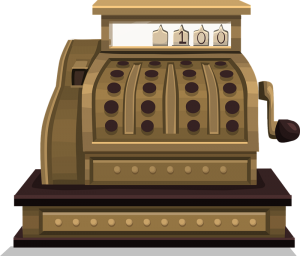 Here we go again. Another story about how one country is starting to go cashless and the pundits crawl out of the woodwork saying that the United States should do the same.
Here we go again. Another story about how one country is starting to go cashless and the pundits crawl out of the woodwork saying that the United States should do the same.
There are a lot of reasons why this will not happen in the United States. One of the biggest reason is the overall economic impact that can affect the actual strength of the U.S. dollar as the world’s reserve currency.
The strength of the U.S. dollar is based on the (relative) security of our government and that the Gross Domestic Product (GDP), the measure of all goods and services produced within a country. According to The World Bank 2016 data (the latest available), the United States has the largest economy with a GDP of over $18.6 trillion. Sweden, the world’s 22nd largest economy, has a GDP of over $514 billion. Their economy is 2.76-percent the size of the United States’s economy.
It is the difference between dumping a bucket of water versus draining an Olympic-sized pool.
But wait, you exclaim, the United States already has an economy that is already electronic and should be able to follow suit. According to the Federal Reserve Bank of San Francisco, based on 2016 data, 31-percent of all transactions are made in cash. Most of the cash usage, 60-percent, are for transactions of $10 or less with lower income people preferring cash over middle and higher income consumers.
“Since 2009, the compound annual growth rate (CAGR) for the number of notes in circulation has been 5.6 percent, with the value of currency in circulation growing at a 7.4 percent annual growth rate,” reports the San Francisco Fed.
When we are not using cash, we are using cash equivalences such as debit cards and pre-paid debit and credit cards. Credit-related purchases account for approximately 20-percent of all transaction.
Cash is not going away anytime in the near future which means that the U.S. Mint and Bureau of Engraving and Printing will continue to produce collectible numismatics for quite some time.
And now the news…

February 18, 2018
At a public toilet in a shopping centre in Gothenburg, a struggle is taking place between old and new Sweden. Last year, the the shopping centre installed cash-free toilets, forcing customers to pay with their mobile phones – a process new to most.  → Read more at theguardian.com
→ Read more at theguardian.com

February 18, 2018
South African Reserve Bank subsidiary, the South African Mint, has announced new collectables product ranges that will appear in the global coin market this year, including the ‘Celebrating South Africa’ series, which will commemorate the life of former President, distinguished Statesman and global icon Nelson Mandela.  → Read more at m.engineeringnews.co.za
→ Read more at m.engineeringnews.co.za

February 19, 2018
The coin, dubbed the Jewelled Phoenix, was crafted from 99.9 per cent pure gold and inset with 1.22 carats of rare, natural fancy pink diamonds from Rio Tinto’s Argyle diamond mine in Western Australia.  → Read more at jewellermagazine.com
→ Read more at jewellermagazine.com

February 21, 2018
FOR 60 years, generations of children have grown up with the lovable, marmalade-eating bear, created by the late Michael Bond. But now, it has been announced the Queen has ordered a batch of specia…  → Read more at thesun.co.uk
→ Read more at thesun.co.uk

February 23, 2018
CHAMBERSBURG, Pa. — The Franklin County (Pa.) Veterans and 9/11 Memorial Park now has a commemorative coin for guest speakers, dignitaries and donors.  → Read more at heraldmailmedia.com
→ Read more at heraldmailmedia.com

February 23, 2018
Japan’s government has unveiled designs for 5 commemorative coins for the 2020 Tokyo Olympics and Paralympics.  → Read more at www3.nhk.or.jp
→ Read more at www3.nhk.or.jp

February 23, 2018
CHANDIGARH: When the collection of original Sikh coins is available at half the price in the open market, the Punjab Government has paid lakhs of rupees to a private firm just for minting duplicate coins.  → Read more at tribuneindia.com
→ Read more at tribuneindia.com

February 23, 2018
JIM THORPE — Jim Thorpe Neighborhood Bank on Broadway was very busy with customers looking to get the latest Native American $1 coin. Take a closer look and you’ll see why. The coin has the face of the borough’s namesake etched into it — Jim Thorpe. "We actually heard about it at another store that they were getting coins issued for Jim Thorpe. It was very enjoyable to find out so we decided to walk down and come over here to the bank," said David Knarr, Hellertown.  → Read more at wnep.com
→ Read more at wnep.com

February 23, 2018
Kitco News' Weekly Gold Outlook recaps how the week's events affected the gold market, and where expert analysts think the metal is headed next. Every Friday, get an in-depth look into the metals space and see how experts see the fundamentals set up gold in the week ahead.  → Read more at kitco.com
→ Read more at kitco.com

February 24, 2018
THERE’s a new 50p coin causing a stir with collectors.  → Read more at dailystar.co.uk
→ Read more at dailystar.co.uk
Feb 22, 2018 | commentary, counterfeit, currency, education, scams, security
It is difficult to turn on the television, read the news, or visit social media without the tragedies of the day smacking us in the face. Although crime statistics are the lowest it has been in generations, there are some crimes that have seen a rise. Those are the crimes that are given the headlines and the most airtime on the news.
Unfortunately, the news extends beyond the mainstream but extends to Main Street.
Numismatics has not been a stranger to the criminal element. If it is not embezzlers using coins to defraud people and governments, there are the counterfeits primarily coming from China. Now there are two new scams that the industry has to watch.
Counterfeiting currency is definitely not a new issue. Counterfeiting the currency that is supposed to be the most secure is something that is now hitting the mainstream, especially in countries that have adopted the use of polymer notes, is important news.
Police in Saskatoon, Saskatchewan has reported the confiscation of 72 bogus Canadian banknotes. Counterfeiters are using a combination of printed plastic sheets and physical cut-and-paste of lower denomination notes to mimic higher denomination notes.
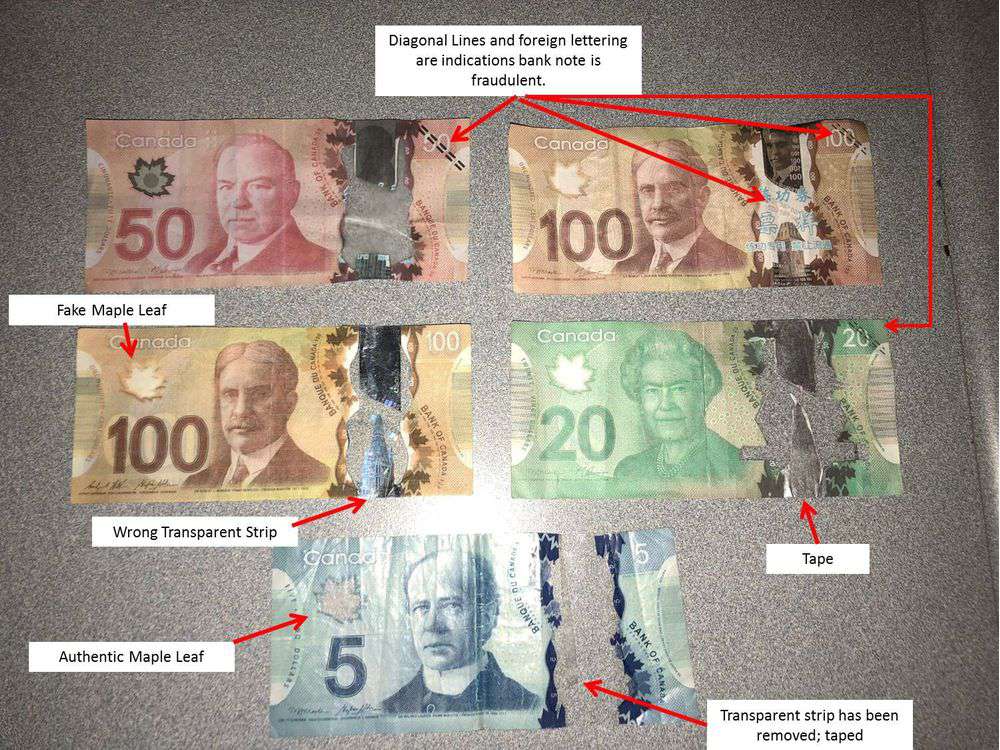
Image released by the Saskatoon Police showing the counterfeit currency (Image courtesy of the Saskatoon Police via the Saskatoon StarPhoenix)
Within the same news feed, the Bank of England issued warnings and additional guidance after counterfeit notes were used for purchases at pubs in Lincolnshire. Many stories from the U.K. suggest that the people do not seem to like the new polymer notes, but this does not seem to help.

Bank of England wants people to watch for the color shifting ink in the quill (Bank of England image)
The Reserve Bank of Australia (RBA), Australia’s central bank and the primary developer of the polymer substrate used around the world, has found that their currency is under attack by industrious forgers. One particular forger found a plastic substrate similar to the polymer developed by the RBA. The forger bought one high-quality commercial printer from the used market and rented two others to print Australian $50 notes.
According to the reports, the $50 note was picked because it provides is common enough to be used in daily transactions (AU$50 is equivalent to US$39.06 as this is being written) and high enough of a denomination to be cost-effective for the forger. Remember, forgery may be a crime but it is a business.

A counterfeit Australian $50 note has the wrong security stripes and the star field on the right is supposed to be clear (Image courtesy of The Sydney Morning Herald)
Although these issues have not directly affected the collectible currency market, it has had an effect on the dealers when their customers pay in cash. Even with the rise of electronic transactions, many European dealers continue to do over-the-counter sales using cash. In some countries, like Germany, cash is still king even when purchasing rare coins.
While discussing these issues with a dealer based in Germany, it was reported that he will not accept large sums of cash from customers he has not done business with in the past. This dealer does not accept credit card payments over 200€ or for any bullion-based transactions. His regular customers can directly wire the funds to a special account the dealer set up. Others must use certified bank checks.
This is not to suggest wire transfers are safe. In a blog post on Kovels.com, they have been contacted by antique dealers that reported money stolen by wire transfers. According to the blog post:
The fraudsters hack your emails and insert their own email, cloned to look like an email from a trusted person, into your email stream. They then request a wire transfer — providing all needed wire instructions — for something that looks legitimate. Once a bank wire is sent, it is extremely difficult, if not impossible, to get the money back. If you need to send a wire, be sure to use “old” technology and confirm on the telephone with someone that you know!
Even though I am no longer in the information security business, it is still my obligation to remind you that EMAIL IS NOT A SECURE FORM OF COMMUNICATION! Email is the electronic equivalent of a postcard. Any message you send, unless it is encrypted, can be read, scanned, snooped, and even altered by anyone, anywhere, at any time.
“Oh, it cannot happen to me!”
I used to hear that line when I taught a senior-level college class on information security. Using a laptop connected to an overhead projector, I was able to show the class how easy it was not only to create spam but to make it look like an email was sent by someone else. I was also able to demonstrate how to read the email traffic on the local network with a few keystrokes. Are you using wireless connections? You just made stealing your information easier for the hacker.
Counterfeiting and wire fraud are not just problems for dealers. When dealers are defrauded by these criminals, they have to recover the money in some way. Insurance does not cover all losses or the extra security that will be required to protect their transactions. Prices will have to go up to cover the losses and the future costs of doing business.
The cost of doing business in this environment is not a trivial subject. While dealers of all types of collectibles want you business, fraudsters are making it difficult for dealers trust the off-the-street buyer. This makes counterfeiting and fraud a problem for everyone.
Jan 26, 2018 | currency, foreign, history
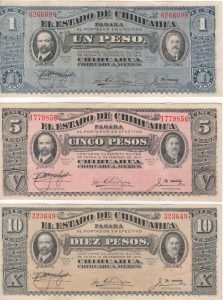 This past week, I was looking into a box I purchased from an estate and I found a plastic bag of old foreign currency. When I removed the notes, I found common notes that can usually be purchased from estate especially since he was a career military officer. There was everything from German Notgeld to several European and Asian countries.
This past week, I was looking into a box I purchased from an estate and I found a plastic bag of old foreign currency. When I removed the notes, I found common notes that can usually be purchased from estate especially since he was a career military officer. There was everything from German Notgeld to several European and Asian countries.
During my search, I found three notes that were intriguing. All three notes were from El Estado de Chihuahua, the State of Chihuahua. They were beautifully preserved (albeit with a fold down the center) one-, five-, and ten-peso notes with the same design but in different colors.
Under the printed denomination are the words “Conforme al Decreto Militar de Fecha Io de Febrero de 1914” (Pursuant to the Military Decree dated February 1914). I vaguely remember that was the era of Pancho Villa and his romp through the southwest United States. Time to refresh my history.
After the 35-yearlong regime of Porfirio Diaz, he was challenged in the presidential election by Francisco I Madero in 1910. Madero was in favor of reform and social justice. But Diaz fixed the election declaring he won by a landslide.
Before the election Diaz had Madero jailed and when it became obvious the election was fixed, Madero supporter Toribio Ortega formed a militia in Chihuahua to oust Diaz.
While in jail, Madero issued a “letter from jail” that declared the Diaz presidency illegal and called for a revolt against Diaz. The revolt began in November 1910. Diaz was ousted and a new election was held in October 1911 that elected Madero the 33rd President of Mexico.
Mexico was divided into districts managed by different governments and protected by rebel leaders including Pascual Orozco, Pancho Villa, and Emiliano Zapata. Eventually, they turned on Madero and assassinated him on February 13, 1913.
The United States first played a role in 1914 when Pancho Villa plundered parts of New Mexico. In 1916, Gen John J. Pershing was sent to Mexico to capture Villa but could not do so since Villa was hiding in the mountains of northern Mexico. Pershing was able to get some of the fighting to stop and, along with the Catholic Church and several affiliated political parties, forced the negotiation of the Constitution of 1917.
Although the notes were authorized in February 1914, the Chihuahua government did not have the ability to print notes. Eventually, they contracted with the American Banknote Company to produce the notes. They were issued in 1915.
To expedite production, all notes feature the same design engraved with different denominations and printed using different colored inks. Many of the elements used were standard to American Banknote’s catalog, for these notes, the portrait on the left is of Francisco I. Madero and the portrait on the right is Governor Abraham Gonzalez. Each features three signatures of the Tesorero General (General Treasury), Gobernator (Governor), and Interventor (Controller). As with many signatures, it is difficult to interpret their names from the handwriting. Please contact me if you have more information.
-
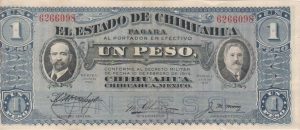
-
Chihuahua Revolutionary 1 Peso Banknote. 1915 Series L (SCWPM #PS530e)
-
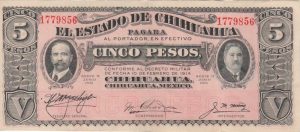
-
Chihuahua Revolutionary 5 Pesos Banknote. 1915 Series N (SCWPM #PS532e)
-
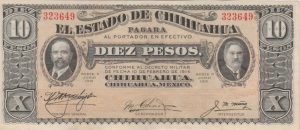
-
Chihuahua Revolutionary 10 Pesos Banknote. 1915 Series N (SCWPM #PS535a)
Reverse if these notes feature a framed picture of the Palacio de Gobierno do Chihuahua (Government Palace of Chihuahua) held by two griffins. When the notes were issued from the banks in Chihuahua, they received a red stamp from Tesorero General del Estado Chihuahua (General Treasury of the State of Chihuahua) along with the stamped initials of the issuing teller. When the notes were issued, the teller was supposed to stamp the date on the reverse but that was not universally practiced.
-
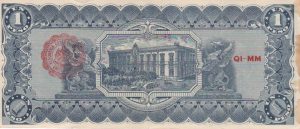
-
Chihuahua Revolutionary 1 Peso Banknote. 1915 Series L (SCWPM #PS530e)
-

-
Chihuahua Revolutionary 5 Pesos Banknote. 1915 Series N (SCWPM #PS532e)
-

-
Chihuahua Revolutionary 10 Pesos Banknote. 1915 Series N (SCWPM #PS535a)
In addition to the one-, five-, and ten-peso notes, the Chihuahua government issued 20- and 50-peso notes as well as a 50-centavos fractional note. Both the 20- and 50-peso notes featured the same design except the 20-peso note was printed using brown ink and the 50-peso was printed with a bright green on the front and a golden yellow on the reverse.
The 50-centavo fractional note used a different design and was smaller than the pesos. It was also printed by the American Banknote Company.
These notes were demonetized in 1917 with the signing of the new constitution.
An Educational Opportunity
Money is history in your hands. Look at what can be learned from finding three banknotes and exploring their past and how they fit into history.
Here is an idea for history teachers: you can go to any coin show and find a dealer with a junk box of foreign currency—find more than one if you can to increase the variety. Pick through the box and try to find as many different pieces of currency you can. Try to find a mix of countries, regions, and dates. You can also consider the same country but from different eras of rulers, who always wanted to see their portrait on their country’s money.
Before going to class, place each note in an envelope and place the envelope in a bag. Either pass the bag around the room or have each student come up and pick one envelope. After they pick their currency note, have them write an essay about the note and what the note represents. Have the students look up the history and put it in context of when the note was issued.
Rather than picking a topic, it is a fun way to have the students select a topic and make history come to life. The decisions as to whether the students get to keep the currency are up to you. Maybe you can talk to a local shop or club to see if they would be willing to donate the currency and come in to talk about currency collecting.
Oct 23, 2017 | coins, currency, poll
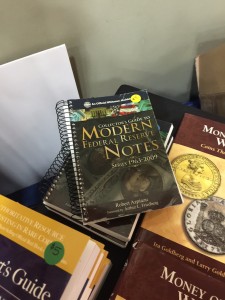 While thinking about modernizing the hobby it came to me that there is one aspect of the hobby that may still be stuck in the 20th century and that is price guides.
While thinking about modernizing the hobby it came to me that there is one aspect of the hobby that may still be stuck in the 20th century and that is price guides.
Price guides are supposed to be the guide that tells buyers and sellers the value of a coin. But over the years price guides went from being an art form to a statistical business with many different players vying for your attention.
Some of these guides have a good reputation while others may not be considered the best sources for prices. In either case, collectors have been known to use both the good and not so good to determine the price of their collectible because ultimately, the price is what you are willing to negotiate with the dealer to pay for the item regardless of what the guide says.
I started thinking, what do collectors use as their guide for pricing? Do they use more than one guide? If they buy a hardcopy (“dead tree edition”) do they buy new copies every year?
Today’s poll wants to know what you use to determine the price of your collectible or the acceptable price to buy or sell that special item.

Loading ...

 → Read more at bristolpost.co.uk
→ Read more at bristolpost.co.uk → Read more at pagesix.com
→ Read more at pagesix.com → Read more at jns.org
→ Read more at jns.org → Read more at nysportsday.com
→ Read more at nysportsday.com → Read more at beckett.com
→ Read more at beckett.com → Read more at cnn.com
→ Read more at cnn.com → Read more at aawsat.com
→ Read more at aawsat.com







 Last week, I
Last week, I 
 Here we go again. Another
Here we go again. Another 









 While thinking about modernizing the hobby it came to me that there is one aspect of the hobby that may still be stuck in the 20th century and that is price guides.
While thinking about modernizing the hobby it came to me that there is one aspect of the hobby that may still be stuck in the 20th century and that is price guides.